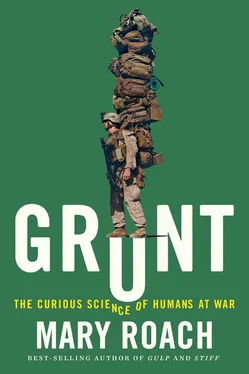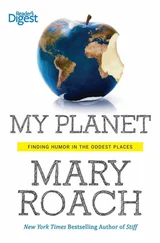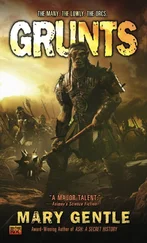Fast-forward to Afghanistan: land of the hundred-pound IED. To get around the up-armoring, insurgents came at vehicles from below, burying the explosives in the middle of the road rather than on the sides of it. As on most trucks, the chassis on US combat vehicles at that time were flat. Where newer generations of vehicles have V-shaped or double-V-shaped chassis to deflect the energy unleashed in a blast, the flat ones took it head-on. And because the seats were bolted to the passenger compartment floor, the energy would transmit directly to passengers’ feet, spines, and pelvises. Smacked them bad.
Newer vehicles have higher clearance. The force of a blast diminishes rapidly as it radiates outward. The energy at one or two feet is still so condensed that it can act like a solid projectile and break through vehicle floors. Once the integrity of the hull is breached, any loose piece of vehicle or gear becomes a projectile. Soldiers and Marines would pile sandbags on the floors of Humvees for the same reason aviators used to sit on their body armor instead of wearing it. Because death came up from below.
The underbody blast scenario was dire enough that US Central Command rolled out the procedural big guns: They issued a JUON (say, joo-on ): a Joint Urgent Operational Need Statement. The statement surely ran longer than fifteen words, but the gist was this: Get us some combat vehicles that can drive over bombs and keep everyone inside alive. Nine vendors submitted prototypes for what would come to be known as MRAPs (say, em-wraps ): mine-resistant, ambush-protected. But without fielding them first, how do you know which one is safest—and precisely how safe it is? You hire a “personnel vulnerability analyst.”
The Army Research Laboratory snapped up Nicole Brockhoff, premed at Johns Hopkins, with a graduate degree in biodefense. The youngest person to win the Secretary of Defense Meritorious Civilian Service Award. Bench presses 190. She’s come down from her office in the Pentagon to attend to some things, and agreed to make me one of them. Whenever Mark takes over the explaining, Brockhoff drops back and takes out her phone. She does not seem rude, just grindingly busy and determined to stay on top of her day. I see her come and go in my peripheral vision, pacing, answering email. She gives the impression of someone for whom idleness is almost physically unbearable. She is gorgeous, articulate, fast-moving, powerful. Lesser humans left blinking in her wake.
Brockhoff offers to show me another anti-IED modification: the energy attenuating seat. We climb inside the passenger compartment of a Stryker infantry carrier, which does not have a door but rather a drop-down ramp, like a circus boxcar. The first good thing about these new seats is that they are no longer bolted to the floor. Second, they ride on special shock-absorbing pistons. What’s special are the collapsible, replaceable metal inserts that slow the seat’s downstroke and keep it from bottoming out. The catch is that in order for passengers to protect their feet and lower legs, they need to keep them off the floor. The footrests on the base of each seat are for the person sitting directly across. Meaning that one soldier has to straddle the other’s knees for hours at a time. Mark, who has joined us, adds that having the knees up like that tends to make the butt go numb. “Like when you’re reading on the toilet too long. And you get toilet palsy.”
The last two words hover, finding nowhere to touch down. “Man thing,” Brockhoff decides.
On a long drive, fighters’ feet surely stray from the safety of the footrests. But their commanders likely know which parts of the route are riskiest and can give a heads-up.
Speaking of heads and up, I ask about airbags on the ceilings, to prevent brain injury. Unfortunately, automotive airbags don’t respond quickly enough to get the jump on a blast. Early on in her tenure at the Pentagon, Brockhoff found herself talking to a general about the challenges of high-speed energy mitigation. He suggested she talk to NASCAR.
“I said, ‘With all due respect, General….’” The bottom of a personnel carrier is traveling many, many times faster than a NASCAR race car. And unleashing a force of many times greater magnitude. Besides, NASCAR’s approach won’t work for combat vehicles. Race car drivers are packed in their seats like mail-order stemware. Heads are braced and supported, so necks don’t break and brains don’t ricochet against skulls. Danica Patrick can’t even look out the driver-side window and wink at the pit crew. That’s no good for combat vehicles. Drivers and gunners need to be scanning in all directions, looking out for suspicious elements: piles of trash or dead goats that might be hiding bombs, people holding cell phones that might be wireless detonators, children with their fingers in their ears.
At the same time that the Army was working to make existing vehicles safer, they were scrambling to evaluate the new MRAPs. When Brockhoff arrived, her colleagues were using the crash test dummy that the auto industry uses: the Hybrid III. First, because that’s what there is. And second, because it makes some sense. Both a car crash and an underbody blast cause blunt force trauma: the sorts of injuries you get from slamming into pieces of a vehicle’s interior. (As opposed to injuries caused by a blast pressure wave passing through you—rupturing organs and eardrums and the like—which a vehicle largely protects against.)
Here’s the problem: automotive crash test dummies were designed for measuring force mainly along two axes—front to back (for head-on impact), and side to side (for “T-bone” crashes). With a blast coming up from below, the axis of impact runs vertically through the body: heels to head. “This doesn’t,” Brockhoff told her colleagues gently, “seem like it’s going to be sufficient moving forward.” To make the point, a Hybrid III was filmed alongside a cadaver in a controlled blast. It is clear, from the slow-motion footage, that this dummy wasn’t built for this. It’s like watching an elderly, arthritic man try to follow along in a Zumba class. Compared with the flailing arms of the cadaver, the dummy’s barely move. When the real head comes down, the dummy’s is coming up. Its thighs rise a third as high off the seat as the cadaver’s, and its ankles barely flex.
The Hybrid III captures the basic pattern of injury—feet, lower legs, spine—but it doesn’t provide the level of detail Brockhoff’s team needed. “We were missing a lot of nuance about the severity of the injury. We needed to know, at what point do you go from a treatable injury that’s recoverable to something life-altering and incapacitating and potentially fatal? We need to be able to make those distinctions when we’re testing these trucks. And we can’t right now.”
So the Army is building a dummy of its own. WIAMan—the Warrior Injury Assessment Manikin—will be specifically tailored for underbody explosions. The project employs about a hundred people (most of whom, as far as I’ve been able to determine, have never watched Jackass and thus had no knowledge of the dwarf cast member Wee Man).
WIAMan is starting the way the automotive crash test dummy people started: with cadavers and bioengineers and controlled blasts of varying magnitude, followed by autopsies to document the injuries. Before they could start any of that, they had to build a blast rig, something robust enough to withstand an explosion directly below it. The tower, as it is conversationally known, stands in a meadow near what the mapmakers call Bear Point and the Aberdeen Explosive Effects Branch calls Experimental Facility 13. I am headed over to EF13 after lunch. The cadavers are there already, sitting in seats on the tower platform. They arrived a day ago from bioengineering labs at three universities. Some made the trip in a modified horse trailer, disappointing the children in passing cars craning their necks for a glimpse of tail or rump.
Читать дальше












